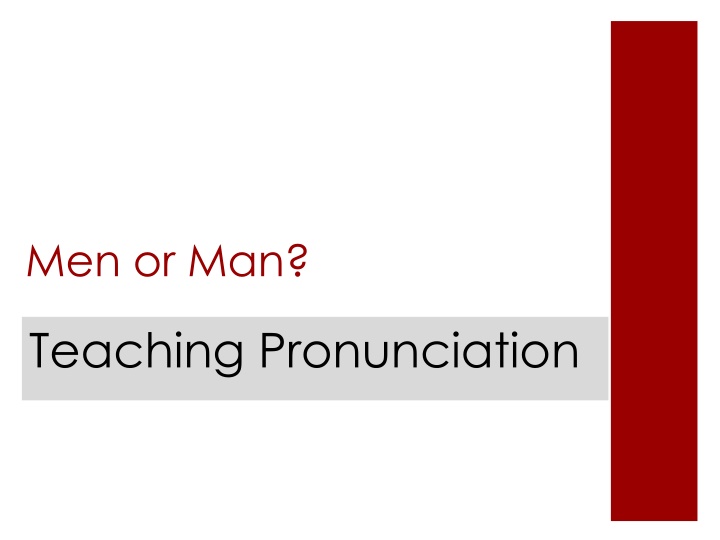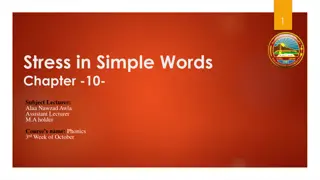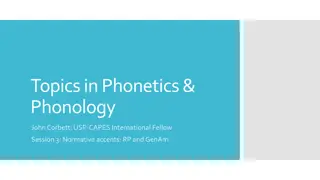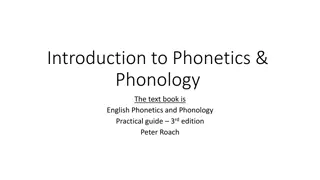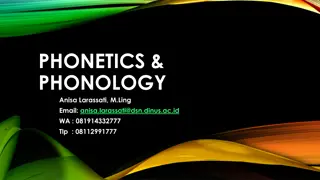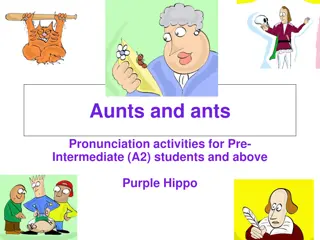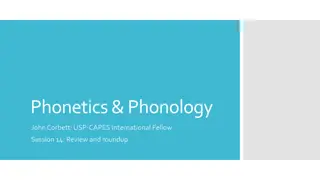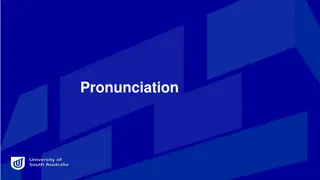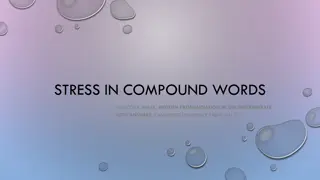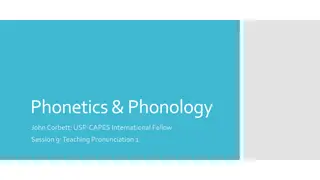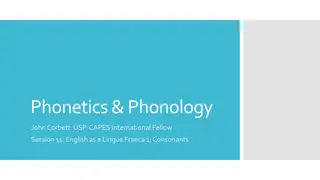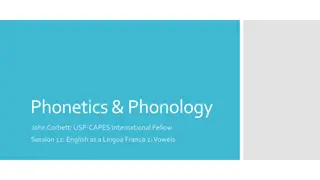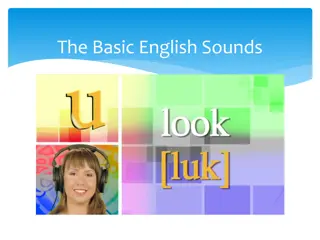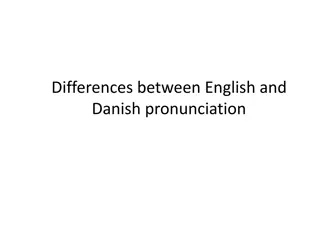Effective Techniques for Teaching Pronunciation in English
Explore issues in teaching pronunciation such as overemphasis on native-like pronunciation, the influence of native language on second language acquisition, precision versus intelligibility, and various teaching methods. Gain insights on common pronunciation problems, techniques for improvement, and engaging activities to enhance pronunciation skills.
Download Presentation

Please find below an Image/Link to download the presentation.
The content on the website is provided AS IS for your information and personal use only. It may not be sold, licensed, or shared on other websites without obtaining consent from the author.If you encounter any issues during the download, it is possible that the publisher has removed the file from their server.
You are allowed to download the files provided on this website for personal or commercial use, subject to the condition that they are used lawfully. All files are the property of their respective owners.
The content on the website is provided AS IS for your information and personal use only. It may not be sold, licensed, or shared on other websites without obtaining consent from the author.
E N D
Presentation Transcript
Men or Man? Teaching Pronunciation Giving Instructions
Who am I? Daniel Moonasar Certified Teacher U.S.A 10 yrs. teaching experience 5 yrs. U.S. 5 yrs. South Korea MRes- Educational and Social Research Assistant Professor of English at Gimcheon University EPIK/ TaLK Teacher Trainer KOTESOL Presenter Corporate English
Objective Objective: To provide participants with: 1. Issues in teaching pronunciation 2. Discuss techniques 3. Sample activities 4. Shared activities
Problems with Pronunciation Activity 1: 1. What problems do you and your students have with pronunciation? 2. Write down some problems. 3. Wait 4. Make groups of 4 5. Share your problems with each other
Problems with Pronunciation Activity 1: 1. What problems do you have teaching pronunciation? 2. Write down some of your problems. 3. Wait. 4. Make groups of 4. 5. Share your problems with each other.
Issues Teaching Pronunciation 1. Over emphasis on native like pronunciation 2. Native language second language 3. Precision vs. intelligibility 4. Various methods 5. Age/ grade level
Issues Teaching Pronunciation 1. Over emphasis on native like pronunciation Perceptions of perfect English Means to measure and rank speakers Who are they speaking to?
Issues Teaching Pronunciation 2. Native language second language L1 vs. L2 How sounds are formed. Where does it come from? Muscle memory
Issues Teaching Pronunciation 3. Precision vs. intelligibility Loss of intelligibility Incorrect stresses, rhythm, & intonation Speed and over-enunciation Imitation
Issues Teaching Pronunciation 4. Various Methods Dozens of phonetic alphabets Encompassing vs. detailed Testing vs. real life
Issues Teaching Pronunciation 5. Age/ Grade Level Typically el. 4th grade m. 1st From feeling to technical
Issues Teaching Pronunciation 1. Over emphasis on native like pronunciation 2. Native language second language 3. Precision vs. intelligibility 4. Various methods
Teaching Pronunciation What are the traditional focuses on teaching pronunciation? 1. Sounds (phonemes, phonics) 2. Rhythm and stress (articulation) 3. Flow of speech (intonation) 4. Accent *many of the following activities overlap focuses. *There are no magic techniques
Teaching Pronunciation 1. Sounds (phonemes, phonics) Minimal Pairs Identifies like sounding words/ sounds- man/ men, coffee/ copy Identify L1 specific problems. - r/l/ p/q/ , c/s/sh/
Teaching Pronunciation Sounds (phonemes, phonics) Minimal Pairs Bingo 1. Introduce some minimal pair words (MPWs). 2. Give students a 3x3 Bingo grid. 3. Have students write MPWs randomly on the grid. 4. Teachers say the words, students mark the MPWs they hear.
Teaching Pronunciation Sounds/ Intonation/ articulation Feeling Sounds Students touch and feel sounds as they make them. Close eyes Change Each other
Teaching Pronunciation Sounds (phonemes, phonics) Sorting Activities Students are given words and must find the different pronunciations.
Teaching Pronunciation Sounds (phonemes, phonics) Sorting Activities Students are given words and must find the different pronunciations. Teacher says words, students sort them.
Teaching Pronunciation Sounds (phonemes, phonics) Sorting Activities Students are given words and must find the different pronunciations. Read or listen Make a poster Hang it up
Teaching Pronunciation Rhythm and stress + flow Singing/ Chanting/ Jazz Chanting Have students use their favorite songs time students spin for songs- reading/ pronunciation. Have students use vocabulary words to make chants Have student record chants, edit them to music.
Teaching Pronunciation Rhythm and stress + flow Singing/ Chanting/ Jazz Chanting Scaffold Show the text Read the text Chant/ clap Model singing Students sing
Teaching Pronunciation Rhythm and stress + flow Singing/ Chanting/ Jazz Chanting How to make & teach jazz chants. http://youtu.be/ZXItVqHL_VY Examples: http://youtu.be/frN3nvhIHUk http://youtu.be/6iHfxfh6lyQ
Teaching Pronunciation Intonation/ Flow Bag of Mystery! Reading/ Intonation Review Use previous readings. Students choose voices out of a bag. Students must read in that voice. scary mouse tiger monster alien
Teaching Pronunciation 2. Rhythm and stress (articulation) Voice recognition apps Kakao Google Translate Google Search Dragon suite Students can read and try to have the app reproduce the reading. Time constrictions so there is no typing.
Teaching Pronunciation 3 +4. Rhythm and stress + flow Intonation pattern charts Very High High redshirt to- a day. John is wearing Medium Low
Sharing Activity What has worked for you? 1. Think about techniques or activities that have worked for you. 2. Share them in your group. 3. Then we ll share together.
Closing and Questions My email address: moonasard@gmail.com
